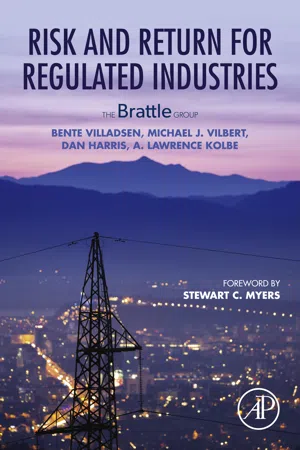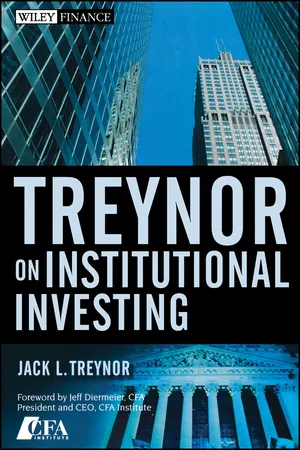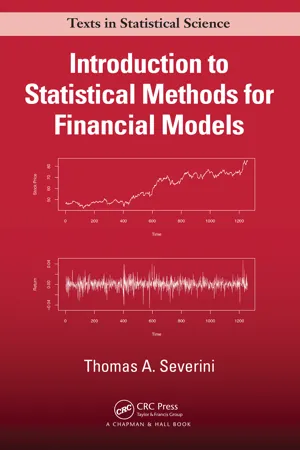CAPM Assumptions
The Capital Asset Pricing Model (CAPM) is based on several key assumptions, including perfect capital markets, investors with homogeneous expectations, no taxes or transaction costs, and unlimited borrowing and lending at the risk-free rate. These assumptions provide the foundation for the model's calculations of expected returns and risk premiums for individual assets within a diversified portfolio.
7 Key excerpts on "CAPM Assumptions"
- eBook - ePub
- Bente Villadsen, Michael J. Vilbert, Dan Harris, Lawrence Kolbe(Authors)
- 2017(Publication Date)
- Academic Press(Publisher)
...Chapter 4 The Capital Asset Pricing Model and Variations Abstract The capital asset pricing model (CAPM) estimates the cost of capital as the sum of a risk-free rate and a premium for the risk of the particular security. In the theoretical version of the CAPM, the best proxy for the risk-free rate is the short-term government interest rate. The risk premium is the product of the premium required on an average-risk investment (called the “market risk premium” or MRP) and the relative risk of the security in question (called beta). The MRP cannot be directly observed nor can a security's true beta. Even the measure of the risk-free rate is subject to debate. The chapter also addresses the problem that empirical tests of the CAPM show that while a stock's risk premium is indeed directly proportional to its beta as predicted by the CAPM, the slope of the proportionality is not as “steep” as the CAPM predicts. Low-beta stocks appear to have higher costs of capital and high-beta stocks lower costs of capital than predicted by the CAPM. Keywords Business risk; Capital asset pricing model (CAPM); Debt-to-equity ratio; Diversifiable risk; Diversification; Financial risk; Gearing; Leverage; Market proxy; Market risk premium; Security market line; Systematic risk; Wright method Introduction This chapter reviews the principles behind the first formal model of how the cost of capital is determined, the capital asset pricing model (CAPM). It describes the estimation of the parameters used in the model, reviews the strengths and weaknesses of the model, and reviews the results of the empirical tests. While probably the most widely used cost of capital estimation method in the world, the CAPM generally has not been confirmed by empirical tests, which has given rise to issues discussed at the end of the chapter. Because a great deal of the financial literature of the last half-century has addressed issues relevant to the CAPM, this chapter is far longer than others...
- eBook - ePub
Investment Valuation
Tools and Techniques for Determining the Value of any Asset, University Edition
- Aswath Damodaran(Author)
- 2012(Publication Date)
- Wiley(Publisher)
...The CAPM is the simplest of the models, insofar as it requires only one firm-specific input (the beta), and that input can be estimated readily from public information. To replace the CAPM with an alternative model, whether it be from the mean variance family (arbitrage pricing model or multifactor models), alternative return process families (power, asymmetric, and jump distribution models), or proxy models, we need evidence of substantial improvement in accuracy in future forecasts (and not just in explaining past returns). Ultimately, the survival of the capital asset pricing model as the default model for risk in real-world applications is a testament to both its intuitive appeal and the failure of more complex models to deliver significant improvement in terms of estimating expected returns. We would argue that a judicious use of the capital asset pricing model, without an over reliance on historical data, is still the most effective way of dealing with risk in valuation in most cases. In some sectors (commodities) and segments (closely held companies, illiquid stocks), using other, more complete models will be justified. We will return to the question of how improvements in estimating the inputs to the CAPM can generate far more payoff than switching to more complicated models for cost of equity. MODELS OF DEFAULT RISK The risk discussed so far in this chapter relates to cash flows on investments being different from expected cash flows. There are some investments, however, in which the cash flows are promised when the investment is made. This is the case, for instance, when you lend to a business or buy a corporate bond; the borrower may default on interest and principal payments on the borrowing. Generally speaking, borrowers with higher default risk should pay higher interest rates on their borrowing than those with lower default risk...
- eBook - ePub
- Jack L. Treynor(Author)
- 2011(Publication Date)
- Wiley(Publisher)
...PART Two CAPM Many investors are uncomfortable with bearing risk. The Capital Asset Pricing Model (CAPM) addresses the question: How will that discomfort be reflected in the way a rational market chooses its discount rates? Which risks will require an extra element of expected return? How much? If they aren’t correlated with other risks, many investment risks that loom large for an individual company, or even for an industry, will have little impact on the market portfolio. But some risks affect so many stocks—so many industries—that they contribute significant risk to the market portfolio. A rational stock market will reward investors for bearing these so-called systematic risks. William Sharpe’s 1963 paper on the Diagonal Model contained a single risk factor to which all stocks were sensitive, albeit in varying degrees, as well as an additional source of risk specific to each stock. Because the latter diversified and the former didn’t, the former explained market fluctuations. In using a single factor to explain the distinction between systematic risk and specific risk, Sharpe’s paper introduced what came to be called the Market Model. However, as he would be the first to point out, more than one macro variable can have enough impact to affect the overall market. The CAPM makes no assumptions about the number of systematic factors. Instead, the CAPM argues that different factors will carry different risk premiums, depending on their impact on the value of the market portfolio. J.L.T. CHAPTER 6 Toward a Theory of Market Value of Risky Assets a The objective of this study is to lay the groundwork for a theory of market value that incorporates risk. We consider a highly idealized model of a capital market in which it is relatively easy to see how risk premiums implicit in present share prices are related to the portfolio decisions of individual investors...
- eBook - ePub
The Capital Budgeting Decision
Economic Analysis of Investment Projects
- Harold Bierman, Jr., Seymour Smidt(Authors)
- 2012(Publication Date)
- Routledge(Publisher)
...The model needs expectations in order to be used correctly. All we have are data based on past events that we may use to estimate the variables that we need. For example, one problem is that the beta will change through time. Also, the value of r f will depend on the maturity of the government security that is used. It is not easy to use the CAPM in an exact manner. One important use of CAPM is in estimating the required expected rate of return for an asset. Required Rate of Return Versus WACC In capital budgeting practice, a commonly used criterion for making accept or reject decisions is to compare the internal rate of return for an investment with the firm’s weighted average cost of capital (WACC). The WACC represents the required rate of return for the firm as a whole and, as its name suggests, is an average. Those who advocate this procedure recommend accepting the investment if its expected internal rate of return exceeds or is equal to the firm’s cost of capital. Figure 8.10 shows both the WACC (WACC = 0.15) and the security market line. The two lines imply different investment criteria; in each case the line is the boundary between the accept region (above the line) and the reject region (below the line). For investments D and G both criteria lead to the same decision. For investments C, E, and F, contradictory recommendations would result. Investments F and E would be rejected by the WACC criterion – but they would be acceptable using the capital asset pricing model approach, even though E yields less than the default-free return. Investment C would be accepted using the WACC of 0.15, but it would be rejected using the CAPM approach. Figure 8.10 A firm with a weighted average cost of capital (WACC) of 0.15 Figure 8.10 illustrates one important limitation of the WACC approach: the fact that it does not take into account variations in the riskiness of different projects...
- eBook - ePub
- Alan J. Baker(Author)
- 2018(Publication Date)
- Routledge(Publisher)
...(Numerous studies illustrate the dramatic reduction in diversiflable risk that can be achieved through the random selection of a fairly small number of securities; see Sharpe, 1978, pp. 113-17.) This helps us to understand why, in equation (xvi), the risk premium for security i depends only on its undiversifiable risk, as measured by β i. Capital market theory holds that the market offers no premium for risks that the individual investor is perfectly capable of neutralising by his own actions in diversifying his portfolio (recall that we are still assuming that all transactions are costless). 10.2 (vi) Qualifications to the Capital Asset Pricing Model Before we consider the strong implications of the CAPM for capital budgeting by firms, we should be aware of the aspects of the model that may cause us to question its practical relevance. The assumptions in this category are: (1) all investors hold the same expectations about all securities and all correlation coefficients, with information about securities’ prospects being made available simultaneously and at zero cost to all investors; (2) all investors can lend or borrow freely at the same risk-free interest rate; (3) there are no transactions costs; (4) the absence of distorting effects of taxation, whether between dividend income and capital gains or between different groups of investors; (5) all investors are similarly motivated in the general nature of their utility functions and the one-period horizon they all observe in their portfolio decision making. We cannot enter here into the considerable literature devoted to the measurement of capital market efficiency in the sense implied by these assumptions and to establishing the robustness of the CAPM under various types of departure from the ideal. (For a summary of various empirical tests of the CAPM, see Firth, 1977, pp...
- eBook - ePub
- Frank J. Fabozzi, Frank J. Fabozzi(Authors)
- 2012(Publication Date)
- Wiley(Publisher)
...Moreover, the theory provides investors with a tool for pricing new financial instruments and nonpublicly traded assets. Cochrane (2001) suggests two popular approaches to asset pricing: absolute pricing and relative pricing. The absolute pricing approach seeks to price an asset by reference to its exposure to fundamental macroeconomic risk. An example of an absolute pricing approach is the consumption-based capital asset pricing model (CAPM) formulated by Breeden (1979). In contrast, the relative pricing approach seeks to value an asset based only on the prices of other assets without reliance on the exposure of the asset to the various sources of macroeconomic factors. The well-known option pricing model formulated by Black and Scholes (1973) is an example of an asset pricing model that employs the relative pricing approach. Most asset pricing models used in practice today are the result of a blend of both approaches. Capital asset pricing models (CAPM), the subject of this entry, are an example. The CAPM starts as an absolute pricing model but then, as will be explained, prices assets relative to the market. There is no attempt in the CAPM to determine how the market risk premium or the risk factor is determined in an economy. In this entry, we focus on the basic CAPM first formulated in the 1960s by several academicians. There have been numerous extensions of the basic CAPM that have been proposed in the decades that followed but these will not be covered in this entry. However, because there is considerable confusion regarding certain aspects of the theory, in addition to describing the basic CAPM in this entry we explain the sources of the confusion and their implications. SHARPE-LINTNER CAPM The first CAPM was that of Sharpe (1964) and Lintner (1965)...
- Thomas A Severini(Author)
- 2017(Publication Date)
- Chapman and Hall/CRC(Publisher)
...However, there are a number of different implications of this result and, in this section, we consider several of these. The CAPM, as given in Proposition 7.1, describes a relationship between the expected return on a portfolio and the expected return on a market portfolio in terms of the standard deviations of the returns and their correlation. However, that result also implies a relationship for the returns themselves. Corollary 7.1. Let R i denote the return on an asset, let R m denote the return on the market portfolio, let R f denote the return on the risk-free asset, and let β i = Cov (R i, R m) ∕ Var (R m). Then we may write R i − R f = β i (R m − R f) + Z i for a random variable Z i that has mean 0 and that is uncorrelated with R m. Proof. Note that Z i may be written Z i = R i − R f − β i (R m − R f), (7.12) where β i is as given in the statement of the corollary. Then, according to Proposition 7.1, Z i has expected value 0: E (Z i) = μ i − μ f − β i (μ m − μ f) = 0. Furthermore, using properties of. covariance, Cov (Z i, R m) = Cov (R i − μ f − β i (R m − μ f), R m) = Cov (R i, R m) − β i Var (R m) = 0 so that Z i is uncorrelated with the market return. It is important to note that it is always true. that R i − μ f = β i (R m − μ f) + Z i where Z i and R m are uncorrelated; the fact that β i = Cov (R i, R m) ∕ Var (R m) implies that Cov (Z i, R m) = 0. The role of the CAPM is to show that E (Z i) = 0. Example 7.2 As in Example 7.1, suppose that the return on the market portfolio has an expected value μ m = 0. 0 2 5 and a standard deviation σ m = 0. 0 4 and suppose that the risk-free rate of return is μ f = 0. 0 0 5. Consider an asset with a return with a mean and standard deviation of μ i = 0. 0 2 and σ i = 0. 0 5, respectively, and suppose that β i = 0. 7 5. Let R i and R m denote the returns on the asset and the market portfolio, respectively...






